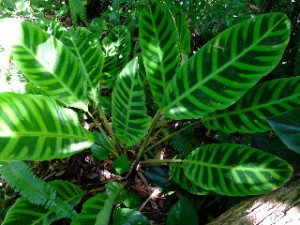Tip of the Week – Focus on Calatheas
 Calatheas produce some of the most striking foliage colours and patterns of all the ornamental plants. There are only a few dozen in the Calathea genus. This genus belongs to the Family Marantaceae…to which Maranta, Ctenanthe and Stromanthe are a few of 31 genus. They are related to gingers and heliconias. Calatheas are native to the rainforests of tropical America. Often called Prayer Plants because at night they fold up their leaves as if in prayer.
Calatheas produce some of the most striking foliage colours and patterns of all the ornamental plants. There are only a few dozen in the Calathea genus. This genus belongs to the Family Marantaceae…to which Maranta, Ctenanthe and Stromanthe are a few of 31 genus. They are related to gingers and heliconias. Calatheas are native to the rainforests of tropical America. Often called Prayer Plants because at night they fold up their leaves as if in prayer.
Calathea Care
Although Calatheas are easy care they do prefer humid conditions. As they are a deciduous plant they die back to their corms in winter in warm temperate and temperate climates. Even in Nambour 90km north of Brisbane they are deciduous. Because they are deciduous they will not be harmed in a colder winter as there is no foliage at this time.
Multiplication
In late spring Calatheas reshoot and you will find you soon have more than you had last season. You can divide them if you like and have more.
Flowering is mostly of botanical interest but a few do have attractive flowers. Calatheas are grown for their eyecatching foliage.
Growing Conditions
In the warm months keep out of afternoon sun. We prefer to keep them out of the rain in winter to make sure they don’t rot off while dormant. Having said that they usually don’t rot if out in the weather. Calatheas like humid conditions and most coastal conditions are humid enough. In dry climates they will grow Ok but may be a risk for disease unless you can supply humidity. They are quite tough in dry conditions but will not thrive without moisture Calatheas make good house plants but like good light. Outside they need to have filtered light or warm morning sun. Calatheas must be well drained.
Potting Mix
Use a well drained potting mix. They like good moisture when its warm but keep just moist when dormant.
Fertiliser
Add slow release granules in spring. Use fish or kelp….don’t overdo it.
Calatheas are great to have. Multipy them up and place strategically inside and out to give your plave a touch of glamour. In warm climate gardens, indoors and in patio pots.
